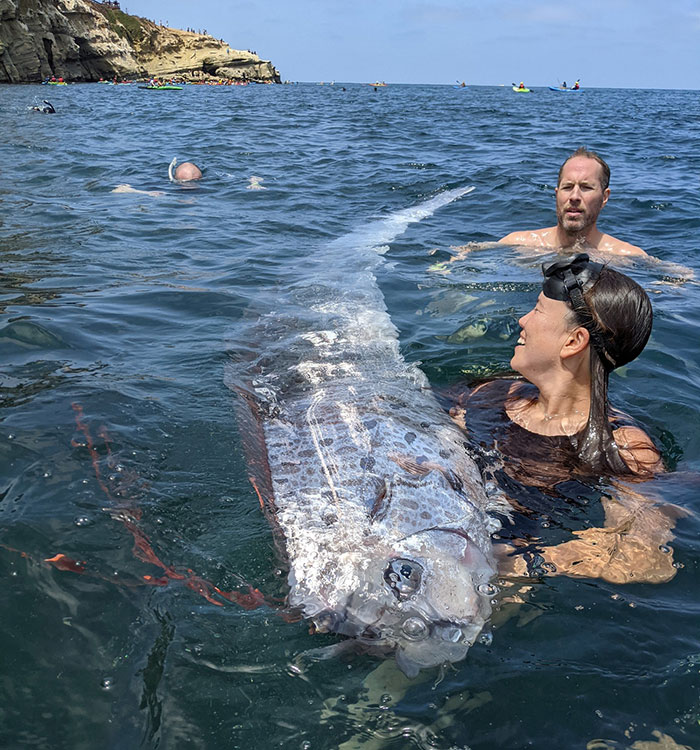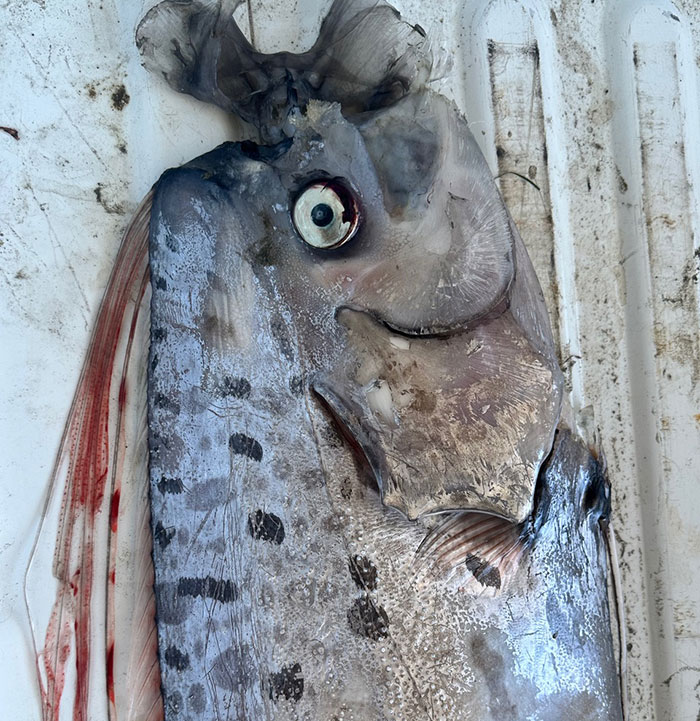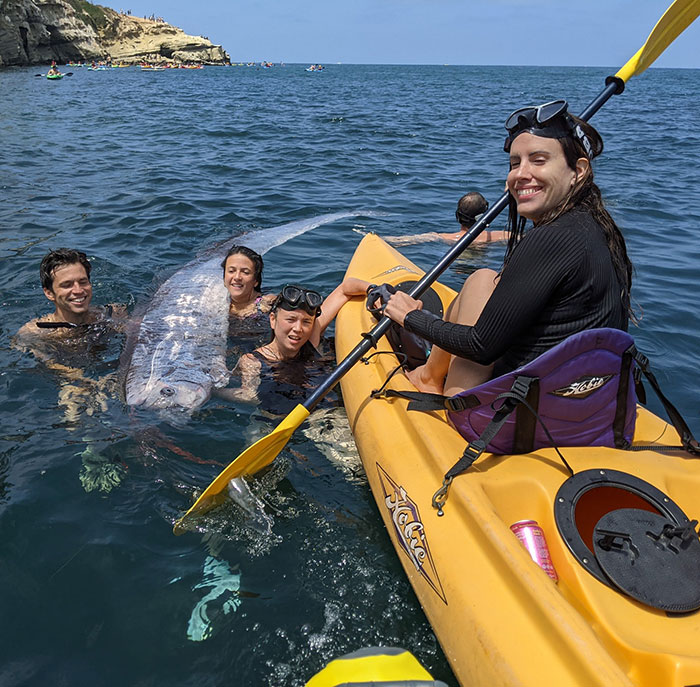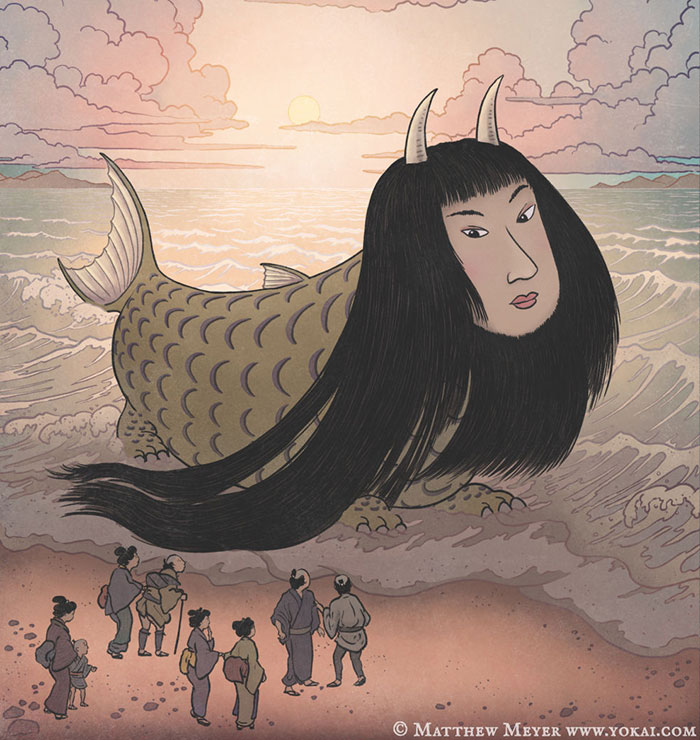A group of friends was expecting to have a totally normal kayak adventure in the waters near La Jolla Cove when they stumbled upon an extraordinary sea creature: an almost 4-meter (12-foot) long sea snake straight from the ocean’s depths.
The massive specimen is known as the oarfish, and it’s not even the largest of its kind.
Named as the largest bony fish in the world by the Guinness Book of World Records, some have been known to reach lengths as large as 11 meters (36 feet) and weigh a maximum of 270 kilos (600 pounds).
The “snake” was discovered floating dead off the coast of San Diego, making it the 20th of its kind to be found along the California coastline since the early 1900s, according to Ben Frable, manager of the Marine Vertebrate Collection at UC San Diego’s Institution of Oceanography.
“They are not commonly seen in California,” he noted, explaining that these creatures are seldom seen on beaches, only surfacing on very rare occasions. “These fish typically inhabit the deep-sea, open-ocean environment.”
Kayak adventurers found an incredibly rare, 4-meter-long “sea serpent” washed ashore in San Diego. It was the latest in only 20 encounters in California waters since 1901
Image credits: Michael Wang
The group quickly alerted officials about their discovery, helping to carry the deceased oarfish to shore for further examinations and taking pictures along the way.
“While there has been research on them, direct interactions with live oarfish in a natural habitat are extremely rare,” Frable explained.
A necropsy will be conducted by a team from the National Oceanic and Atmospheric Administration (NOAA) in order to determine the cause of death, along with a genetic analysis for research purposes into the species’ anatomy, habitat, and role in the deep-sea food chain.
Image credits: Michael Wang
“The oarfish has always fascinated scientists with its long, striking silver body, large eyes and mane-like crest on its head,” he continued. “It certainly evokes images of mythical sea serpents.”
Frable’s comparison rings true, as, historically, the oarfish has been considered an ill omen in Japanese folklore.
The Japanese have long associated the sudden appearance of oarfish on the surface with signs of upcoming earthquakes and storms, making their sightings ill omens
Image credits: Michael Wang
These creatures are known as “Ryugu no Tsukai” in Japanese, which means “messenger from the Dragon God’s Palace.”
According to the legend, oarfish live under the islands of Japan, coming to the surface only when impending disaster is coming, be it earthquakes or storms.
Image credits: Inside Edition
The tale gained renewed popularity in 2011 after a devastating 9.1 magnitude earthquake took the lives of over 19,000 people in Japan and caused the meltdown of three nuclear reactors in Fukushima.
Oarfishes started stranding on the shores of the country in the years preceding the tragedy, with at least 20 specimens being found dead by fishermen at various points, reinforcing the legend.
As speculation grew, experts decided to settle the question of whether oarfish strandings are truly a precursor to natural disasters
Image credits: KPIX | CBS NEWS BAY AREA
Speculation was so rampant that, in 2019, a study was published in the Seismological Society of America’s bulletin to ascertain once and for all whether the creatures were signs of impending doom or not.
Titled “Is Japanese Folklore concerning deep‐sea fish appearance a real precursor of earthquakes?”, the resulting paper found no relationship between the fish’s appearance and earthquakes.
For Hiroyuki Motomure, a professor at Kagoshima University, the connection between the sea serpents and disasters is no more than superstition.
“There is no scientific evidence to suggest that the two events are connected,” he told the New York Post.
Image credits: Matthew Meyer
“I believe these fish tend to rise to the surface when their physical condition is poor, rising on water currents, which is why they are so often dead when they are found.”
According to the professor, the belief comes from the fact that the oarfish’s natural habitat is the deep sea, where they dwell between 200 meters (700 feet) and 1,000 meters (3,280 feet) below the surface.
Dr. Milton Love of the Marine Science Institute of California shares the same opinion as his Japanese peer, pointing out that “there is no evidence that [he] know[s] of to suggest that oarfish come into shallow waters in response to, or preparation of, earthquakes.”
San Diego netizens reacted with a mix of humor and wariness at the news, with some explaining the legend to others, scaring them in the process.
“Oarfish are believed to be the source for a lot of ‘giant sea serpent’ tales and yes, bad omens,” one user explained on Reddit.
“The reason for this is that oarfish usually live in the deep, so when an oarfish washes up that means that ocean currents drastically change, which usually happens before a hurricane.”
“Big earthquake comin’,” said another.
“There was an earthquake that was felt in Poway this morning,” a user noted.
“Until someone proves to me otherwise I’m just going to believe that the oarfish aren’t reacting to the seismic activity, they’re causing it and then running from the consequences of their actions,” joked another.
“It makes sense that their appearances are basically the first wave of reactions to seismic activity. It makes you wonder if something else is going on the other times we see them,” one pondered.
















